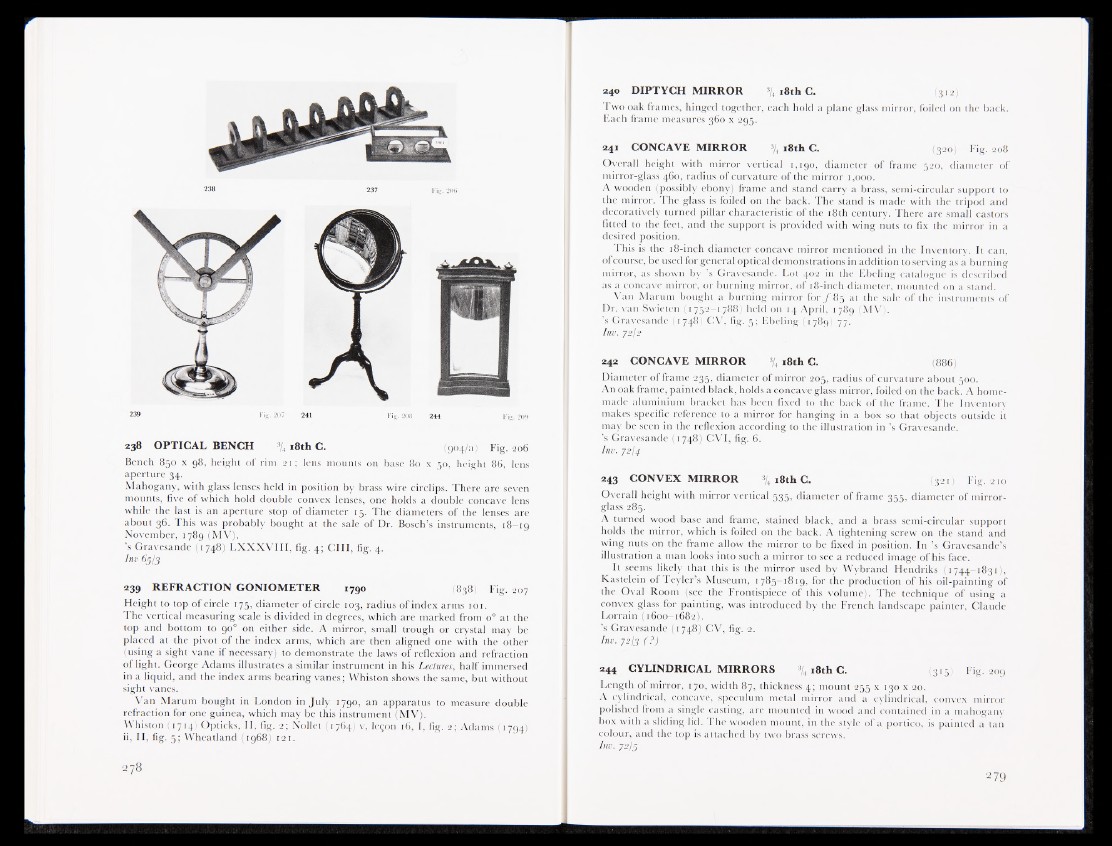
238 Fig. 206
238 OPTICAL BENCH % 18th C. (904/a) Fig. 206
Bench 850 x 98, height of rim 21; lens mounts on base 80 x 50, height 86, lens
aperture 34.
Mahogany, with glass lenses held in position by brass wire circlips. There are seven
mounts, five of which hold double convex lenses, one holds a double concave lens
while the last is an aperture stop of diameter 15. The diameters of the lenses are
about 36. This was probably bought at the sale of Dr. Bosch’s instruments, 18—19
November, 1789 (MV).
’s Gravesande (1748) LXXXVIII, fig. 4; CIII, fig. 4.
Inv 65/3
239 REFRACTION GONIOMETER 1790 (838) Fig. 207
Height to top of circle 175, diameter of circle 103, radius of index arms 101.
The vertical measuring scale is divided in degrees, which are marked from 0° at the
top and bottom to 90° on either side. A mirror, small trough or crystal may be
placed at the pivot of the index arms, which are then aligned one with the other
(using a sight vane if necessary) to demonstrate the laws of reflexion and refraction
of light. George Adams illustrates a similar instrument in his Lectures, half immersed
in a liquid, and the index arms bearing vanes; Whiston shows the same, but without
sight vanes.
Van Marum bought in London in July 1790, an apparatus to measure double
refraction for one guinea, which may be this instrument (MV).
Whiston (1714) Opticks, II, fig. 2; Nollet (1764) v, leçon 16, I, fig. 2; Adams (1794)
ii, II, fig. 5; Wheatland: (1968) 121.
240 DIPTYCH MIRROR % 18th C. (312)
Two oak frames, hinged together, each hold a plane glass mirror, foiled on the back.
Each frame measures 360 x 295.
241 CONCAVE MIRROR % 18th C. (320) Fig. 208
Overall height with mirror vertical 1,190, diameter of frame 520, diameter of
mirror-glass 460, radius of curvature of the mirror 1,000.
A wooden (possibly ebony) frame and stand carry a brass, semi-circular support to
the mirror. The glass is foiled on the back. The stand is made with the tripod and
decoratively turned pillar characteristic of the 18th century. There are small castors
fitted to the feet, and the support is provided with wing nuts to fix the mirror in a
desired position.
This is the 18-inch diameter concave mirror mentioned in the Inventory. It can,
of course, be used for general optical demonstrations in addition to serving as a burning
mirror, as shown by ’s Gravesande. Lot 402 in the Ebeling catalogue is described
as a concave mirror, or burning mirror, of 18-inch diameter, mounted on a stand.
Van Marum bought g burning mirror for ƒ 85 at the sale of the instruments of
Dr. van Swieten.s|i 752-1788) held on 14 April, 1789 (MV).
’s Gravesande (1748) CV, fig>#|,Ebeling (1789) jg,,.
Inv. 72MI
242 CONCAVE MIRROR % 18th C. (886)
Diameter of frame 235, diameter of mirror 205, radius of curvature about 500.
An oak frame, painted black, holds a concave glass mirror, foiled on the back. A homemade
aluminium bracket has been fixed to the back of the frame. The Inventory
makes specific reference to a mirror for hanging in a box so that objects outside it
may be seen in the reflexion according to the illustration in ’s Gravesande.
’s Gravesande (J748) CVI, fig. 6.
Inv. 72(4
243 CONVEX MIRROR % 18th C. (321) Fig. 210
Overall height with mirror vertical 535, -diameter of frame 355, diameter of mirror-
glass 285.
A turned wood base and frame, stained black, and a brass semi-circular support
holds: the mirror, which is foiled on the back. A tightening screw on the stand and
wing nuts on the frame allow the mirror to be fixed in position. I n ’s Gravesande’s
illustration a man looks into such a mirror to see a reduced image of his face.
It seems likely that this; is the mirror used by Wybrand Hendriks (1744—1831),
Kastelein ofTeyler’s Museum, 1785—1819, for the production of his oil-painting of
the Oval Room (see the Frontispiece of this \olume). The technique of using a
convex glass for painting, was introduced by the French landscape painter, Claude
Lorrain (1600-1682).
’s Gravesande (1748) CV, fig. 2.
Inv. 7-2l3 (?)
244 CYLINDRICAL MIRRORS % 18th C. (315) Fig. 209
Length of mirror, 170, width 87, thickness 4; mount 255 x 130 x 20.
A cylindrical, concave, speculum metal mirror and a cylindrical, convex mirror
polished from a single casting, are mounted in wood and contained in a mahogany
box with a sliding lid. The wooden mount, in the style of a portico, is painted a tan
colour, and the top is attached by two brass screws.
Inv. H